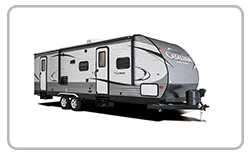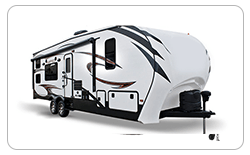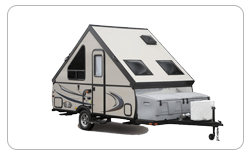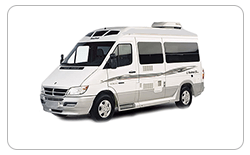Are You Ready?
With summer just around the corner, it is time once again to get all your RV and camping gear in order! Minor emergencies happen all the time when you are out in our beautiful mountains, and I thought I would talk today about preparing for and dealing with some of the bumps in the road you might encounter.
Emergency Kit
Every experienced camper knows that an emergency kit is your best friend when you're out in the woods. Here are some things that every emergency kit should have in it:
*some non-perishable granola or protein bars
*sealed water bottles
*basic first aid components
(i.e. bandages, gauze, bug bite salve, antibacterial ointment, ACE wrap, hydrogen peroxide, sunscreen, aspirin, pink bismuth)
*a roll of toilet paper
*a good length of rope (10-30 feet)
*space blanket
*sewing kit
*a few dollars in change (in case you need a payphone)
Most emergency kits that you can buy in the store will have most of these things in it already, but add to it as necessary. These components will help you to deal with any small emergency that comes your way.
Now, I am trained in mountain survival, and I know that sometimes things can go really weird when you least expect it. So the following items are things that you should add to your basic emergency kit if you are going into the backwoods, or if you are going to be "off the grid" for an extended period of time. These are mainly household objects, and I personally keep my kit in a water-tight plastic tub. If possible, try to carry these items in your backpack so they are always on you.
Big Emergency Kit
*a compact disk (CD)
-the sheen of the bottom side of the disk can help you signal for help
*3-5 lighters (store them in a sealed baggy)
-starting a fire can be key to your survival and rescue
-you definitely want more than one, in case one or two fail
*steel wool
-there is no better tinder for starting a fire than steel wool
*large garbage bag
-you can use the bag to line the floor of your shelter so you don't get wet
*a good knife
-the knife should be thick and preferably serrated
*a whistle
-using a whistle to signal for help saves your voice and some calories
-most wild animals do not like the sound of a whistle, so blowing one can scare off many would be attackers.
*a tin bowl and mug
-the bigger the better
-you should always have something to store water in or cook your food in
*7-10 protein bars
-catching your food in the wild is a lot harder than it looks, so save yourself the trouble
If you do find yourself in a survival situation, the first thing you should do is find a shelter on high ground, and a little ways away from water. Most people's first instinct is to set up shelter near a lake or river, but those areas get much colder at night and get a lot more insect and animal activity. Know where your nearest water source is, but create your shelter away from it. In the summer, make your shelter by leaning felled trees and and branches against a larger standing tree, to form a sort of lean-to. Top those branches with lots of leaves and mud to keep the elements off of you. In the winter, make the same sort of lean-to, but scoop out as much of the snow off of the floor as you can, and use that snow to pack your roof tight. Be sure to spread the trash bag on the floor to help keep you dry.
If you have a lot of daylight left after finding or making your shelter, collect some dry wood and collect some water (try to get your water from a stream or river rather than a lake or pond). Then, you should return to your shelter, and build a fire. Start out with your steel wool and plenty of small, dry twigs and sticks. As the fire catches, slowly add bigger pieces of wood. Once you have your fire going, add plenty of green leaves and small green twigs. Green foliage puts off a lot of smoke, so your fire can be more easily seen from far away.
Your next step is going to be cleaning your water. The water may look pristine in the stream, but there are any number of parasites and nasty bacteria swimming around in it that you can't even see. Last thing you need is to be sick AND lost. First, carefully pull out one or two pieces of your newly charcoaled wood, and set them aside to cool. Next, pour the water you gathered from the stream/river into your metal bowl, and set it to boil. Once it has boiled, remove it from the fire and let it cool. If you can spare a shirt sleeve or a sock, now would be the time to get it out. Pour some of your water over the cloth and wring it out. Set the cloth on top of your tin mug and crush the charcoal that you set aside on top of the cloth. Cover the cloth evenly with the ground charcoal. Pour small amounts of your boiled water through the cloth and charcoal into your cup. The charcoal is a fairly pure source of carbon, which will filter out any bacteria that the boiling didn't. Now you have drinkable water!
These are just a few simple things to do to ensure your survival in a bad situation. However, you really only need to remember this last list to be okay.
*Find shelter on high ground, away from water.
*Build a hot, smoky fire.
*Don't eat anything you find on the ground if you can avoid it.
*Get your water from a running body of water if you can.
*Signal for help in a big way as often as you can.
*Remember the rule of 3's and prioritize accordingly:
-You can go 3 minutes without air.
-You can go 3 days without water.
-You can go 3 weeks without food.
The last bit of survival advice I can give you is that in Colorado, all the old mountain towns were built along rivers. If you are lost, but can find a river, follow it downstream. You are bound to find some sort of town fairly quickly.
Hopefully this has you jumping to go camping, enjoy the beautiful land that Colorado offers us, and prepared to be safe. Happy trails!
-Pehrie
Also, once again, today's picture was taken by my amazing father on one of his camping trips!












